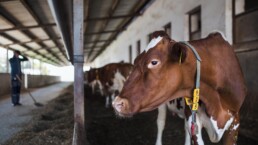Thirty African nations are experiencing energy crisis that costs their economies up to 5% of their GDP. A further 600 million Africans lack access to electricity, yet local communities are producing an abundant amount of plant and animal waste in their day-to-day lives. For the sake of the health of our planet and future generations, we all need to start using the vast amounts of organic waste we produce, as a means of satisfying our ever-growing energy consumption needs.
Biogas is a naturally occurring mixture of 60 to 70% methane and 30 to 40% CO2 with some H2S (Hydrogen Sulfide), that burns similar to so-called natural gas, which is actually a fossil fuel. A biogas digester is a simple system, which produces biogas, via the natural anaerobic decomposition of organic materials.
A biogas digester, once its starter culture of methanogenic (CH4 producing) bacteria has been established, usually several weeks after the initial loadings of animal manures, can be fed daily with liquid and solid residues of animal excrement, human excreta, agricultural residues and household kitchen scraps. The ecosystem of bacteria in the biogas digester extracts energy from the organic material and generates methane gas.
The digested organic (bio-slurry) material exits the system as a high-quality fertilizer in liquid form. This liquid compost still contains all the minerals and other essential soil nutrients from the kitchen and garden waste, including nitrogen, which is usually lost in traditional aerobic composting. I have seen the potential of this liquid compost to transform a barren plot of land into a productive vegetable garden; it should be popularized amongst smallholder farmers as an alternative to traditional fertilizers, which contribute to soil degradation over time.
Biogas is primarily used around the world for cooking and heating homes, but it also has many other important applications both domestically and industrially. During my training in the Renewable Energy Section at the Songhai Regional Center Headquarters in Porto Novo, Benin, I experienced first-hand how biogas was effectively used for lighting and to power several electric generators that are used to drive Songhai’s entire industrial production complex.
Biogas as a fuel at all scales is well established internationally but underutilized as a means of generating energy in Africa. It also has a long history of use in gas lamps and absorption refrigeration systems. When purified and compressed, it can be used as an effective fuel for cars, trucks and buses. Stockholm, Sweden is a leader in this application, with up to 25% of public buses powered by biogas.


Creating an effective and far-reaching modern electrical system for the entire continent will cost over US$547 billion to implement by 2030. This averages to $27 billion per year. African governments and their international allies have managed to raise $4 billion in funding, leaving the financing gap at US $23 billion annually.
Biogas can serve as a flexible substitute for non-renewable energy sources at many levels. Low-income earning women and youths should be given support in the form of funding and proper training on how to setup and maintain household biogas digesters. In so doing, we can ensure that the immense potential of biogas energy is fully tapped into to boost Africa’s new industrial and self-reliant age.
Socio-economic, demographic and political topics related to the adoption of biogas production as a sustainable fuel source for cooking and lighting have been surveyed in Uganda. Family size digesters fed by mainly cow dung and other organic waste from agriculture. show high potential but are not as wide-spread as they could be. In Ethiopia, only 40 % of 1000 biogas production plants, with digester sizes ranging from 2.5 m3 to 200 m3, installed in the last two decades are still running.
Over 100 plants with different digester sizes ranging from 10 m3 to 30 m3 were installed in Ghana in 2011. The biogas generated was mainly used for cooking where no gas purification was necessary. Of the plants visited, only 50% were running properly with no technical issues.
The main reasons for the failure of installed biogas production facilities in Africa are:
- Poor design and construction of digesters
- Wrong operation and lack of maintenance by users
- Poor dissemination strategy by the promoters of biogas technology
- Lack of project monitoring and follow-up by promoters of biogas technology
- Poor ownership responsibility by users
- Failure by local governments to support biogas technology through a focused energy policy.
Since maintenance and trained laborers running the equipment is the most crucial component of maintaining a bio-digester, training centers are vital to familiarize low-income earning women and youths with how to operate a digester effectively. The Songhai Regional center in Benin can serve as a training hub for West Africa and beyond. Their successful model can be replicated at scale.
Africa should learn from Asia, where family size digesters have a more intense application in rural areas in India, Nepal and China. Several examples of well running small-scale biogas production plants can be seen in rural communities in India and Cambodia.
Access to modern forms of clean energy helps to eradicate extreme poverty and hunger, reducing child mortality, improving maternal health and ensuring environmental sustainability. Increased training opportunities on how to set-up and maintain biogas digesters is good for the environment and has the potential to boost economic growth and contribute to generating jobs for 12 million African youths who enter the workforce every year.
Image credit: Waste Management World
The views expressed in this article are those of the author alone and not the Future Africa Forum.
The views expressed in this article are those of the author and do not necessarily reflect the views of Future Africa Forum. Future Africa Forum is a pan-African policy think-tank and policy advisory consultancy headquartered in Nairobi, Kenya.



